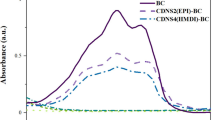Abstract—
Benzophenanthridine alkaloid sanguinarine from Macleaya macrocarpa shows antitumor and anti-angiogenic activity, among others. Some side effects of sanguinarine, which significantly limit the possibilities of its therapeutic use, are described. To increase the effectiveness of its therapeutic effect, sanguinarine was introduced into the pH-sensitive liposomes by remote loading using ammonium dihydrogen phosphate. pH-sensitive liposomes, appearing in the acidic environment of the tumor or endosomal compartment, release sanguinarine, which causes the death of tumor cells. The average diameter of the liposome particles measured by the method of dynamic light scattering was 112.6 ± 1.8 nm; the zeta potential was –13.9 ± 1.7 mV. The effectiveness of the inclusion of sanguinarine in liposomes was 89.54 ± 2.13%. The dynamics of release of sanguinarine from the composition of a liposome preparation was studied, and the prolonged release pattern was demonstrated. The cytotoxic activity (CTA) of liposomal sanguinarine against prostate cancer cell lines LNCaP, DU 145, and PC-3 was studied. Liposomal sanguinarine exhibited dose-dependent CTA against cells of all the studied lines in the micromolar range of concentrations. The highest CTA of liposomal sanguinarine was seen against the hormone-sensitive LNCaP cells (IC50 2.86 μM). For the hormone-independent cells of the DU 145 and PC-3 lines, the cytotoxic activity of liposomal sanguinarine was somewhat lower and amounted to 3.37 μM and 3.63 μM, respectively. A dose-dependent induction of apoptosis of LNCaP, DU 145, and PC-3 cells was also demonstrated. The liposomal sanguinarine with high efficiency induced apoptosis of both hormone-sensitive and hormone-independent cells. The liposomal sanguinarine at a concentration of 8 μM induced apoptosis in 93.14% of LNCaP cells, 90.65% of DU 145 cells, and 98.12% of PC-3 cells. Thus, liposomal sanguinarine can be considered as a promising antitumor agent for the therapy of both hormone-sensitive and hormone-independent tumors.



Similar content being viewed by others
REFERENCES
M. Bambagiotti-Alberti, S. Pinzauti, G. Moneti, et al., J. Pharm. Biomed. Anal. 9, 1083 (1991).
A. K. Salmore and M. D. Hunter, J. Chem. Ecol. 27, 1729 (2001).
K. P?henčiková, J. Urbanová, P. Musil, et al., Molecules 16, 3391 (2011).
M. Stiborova, V. Simanek, E. Frei, et al., Chem. Biol. Interact. 140, 231 (2002).
K. M. Ansari, A. Dhawan, S. K. Khanna, and M. Das, Food Chem. Toxicol. 43, 147 (2005).
V. P. Torchilin, Nat. Rev. Drug Discov. 4, 145 (2005).
M. Wacker, Int. J. Pharm. 457, 50 (2013).
G. Gregoriadis, N. Engl. J. Med. 295, 704 (1976).
G. Gregoriadis, N. Engl. J. Med. 295, 765 (1976).
G. Gregoriadis, Trends Biotechnol. 13, 527 (1995).
J. Kreuter, Int. J. Pharm. 331, 1 (2007).
S. Ganta, H. Devalapally, A. Shahiwala, and M. Amiji, J. Control. Rel. 126, 187 (2008).
S. K. Hobbs, W. L. Monsky, F. Yuan, et al., Proc. Natl. Acad. Sci. U. S. A. 95, 4607 (1998).
G. Y. Zuo, F. Y. Meng, X. Y. Hao, et al., J. Pharm. Pharm. Sci. 11 (4), 90 (2008).
F. Meng, G. Zuo, X. Hao, et al., J. Ethnopharmacol. 125, 494 (2009).
H. Ahsan, S. Reagan-Shaw, J. Breur, and N. Ahmad, Cancer Lett. 249, 198 (2007).
B. C. Jang, J. G. Park, D. K. Song, et al., Toxicol. In Vitro 23, 281 (2009).
D. G. Tang and A. T. Porter, Prostate 32, 284 (1997).
M. Gleave, N. Bruchovsky, S. L. Goldenberg, and P. Rennie, Eur. Urol. 34, 37 (1998).
S. R. Denmeade, X. S. Lin, and J. T. Isaacs, Prostate 28, 251 (1996).
A. Fritze, F. Hens, A. Kimpfler, and R. Schubert, Biochim. Biophys. Acta 1758, 1633 (2006).
X. Zhang, S. Lu, J. Han, et al., Pharmazie 66, 404 (2011).
A. Adan, Y. Kiraz, and Y. Baran, Curr. Pharm. Biotechnol. 17, 1213 (2016).
M. Stubbs, P. M. McSheehy, J. R. Griffiths, and C. L. Bashford, Mol. Med. Today 6, 15 (2000).
Y. B. Hu, E. B. Dammer, R. J. Ren, and G. Wang, Transl. Neurodegener. 4, 18 (2015).
E. Debiton, J. C. Madelmont, J. Legault, and C. Barthomeuf, Cancer Chemother. Pharmacol. 51, 474 (2003).
Z. Ding, S. C. Tang, P. Weerasinghe, et al., Biochem. Pharmacol. 63, 1415 (2002).
Funding
This work was supported by the Russian academic excellence project “5-100.”
Author information
Authors and Affiliations
Corresponding author
Rights and permissions
About this article
Cite this article
Feldman, N.B., Orekhov, S.N., Chakaleva, I.I. et al. Preparation of Liposomal Sanguinarine and Study of Its Cytotoxic Effects against Prostate Cancer Cells. Nanotechnol Russia 15, 230–235 (2020). https://doi.org/10.1134/S199507802002007X
Received:
Revised:
Accepted:
Published:
Issue Date:
DOI: https://doi.org/10.1134/S199507802002007X




